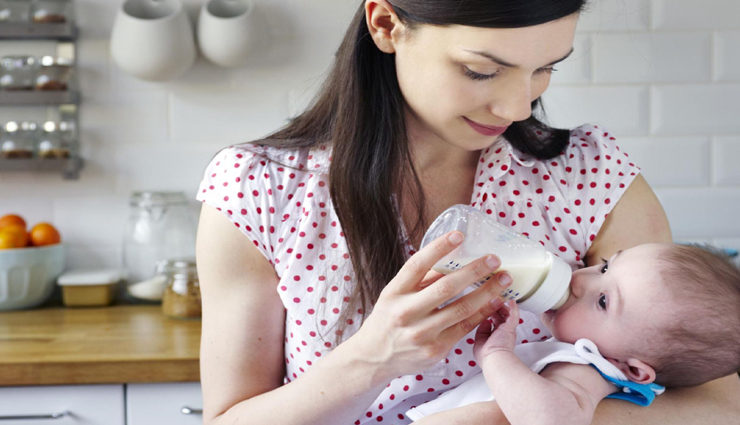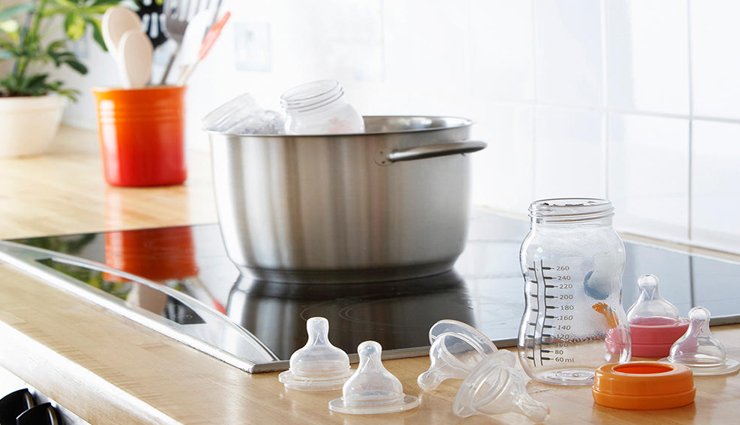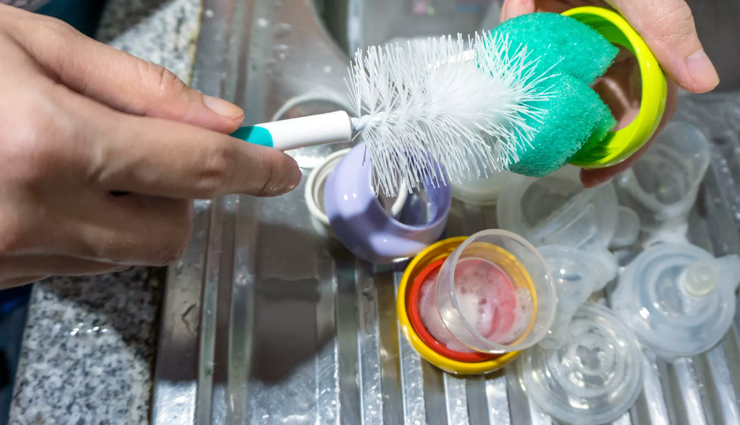- Home›
- Healthy Living›
- 5 Safest Ways To Sterilize Baby Bottles
5 Safest Ways To Sterilize Baby Bottles
By: Priyanka Maheshwari Wed, 09 Sept 2020 8:24:42

The best way for a new mother to establish a nurturing bond with her baby is through breastfeeding. But sooner or later, you will have to switch to other alternatives for feeding your baby. Nursing becomes quite inconvenient when you are running low on breast milk, are in the throes of illness, or are nearing the end of your maternity leave and have to shuffle between work and home.
Your baby’s need to breastfeed can be gradually phased out by switching to a bottle, which is the natural progression that most new parents adopt. Perhaps the greatest comfort associated with bottle feeding is that it can be done by anybody at home, not just the mother. The most prominent con, however, is the effort that goes into cleaning and sterilizing the bottle.
After remaining cocooned in the warm confines of the womb, infants take their own sweet time to adapt and adjust to the foreign environment of the outer world. Moreover, their immune system is still very nascent and underprepared to take on even the everyday germs and bacteria that are usually harmless to adults.
Thus, cleanliness with regard to everything your baby comes in contact with cannot be stressed enough. One key aspect of maintaining such sanitary standards is to keep your baby’s feeding equipment both clean and sterilized.
The mouth is the primary entry point to the body, so it is imperative that you take extra care of what your child is putting in his/her mouth. Sterilization goes a long way in eliminating any trace of microbes from your baby’s feeding bottles and cleaning them thoroughly.

* Sterilization by Boiling
The mechanism behind sterilization through boiling water works by raising the temperature high enough to kill any bacteria left over after washing.[6] This is perhaps the simplest form of sterilization and does not require any special equipment. A basic kitchen pan or pot and clean water are all you need for this method to work. .
However, before you proceed with this method, make sure that the feeding equipment that you want to sterilize is safe to boil.
- Fill an adequately sized pot or pan with sufficient water to cover the feeding equipment that you intend to sterilize.
- Immerse the freshly washed feeding equipment in it such that there are no air traps.
- Cover the pan with a heavy plate or lid that almost touches the surface of the water.
- Place the pan on a stove burner set on high, and bring the water to a boil.
- Let the water boil for at least 10 minutes, and set a timer so you don’t forget to turn the heat off.
- If you plan to prepare the bottle right away, clean your hands and the kitchen surface beforehand. In fact, disinfecting your hands before handling any sterilized equipment is mandatory regardless.
- Use sterilized tongs to pull out the equipment from the pan. To that end, you may want to plunge the tongs into the water while it was boiling and leave them be for some time. Once the heat is turned off, allow the tongs to cool off a bit so that you don’t burn yourself in trying to hold them.
- As soon as you take the equipment out, assemble the lids and teats on the bottles straightaway.
- Give the bottle a shake to get rid of the dripping water, if you need to use them right after sterilization.
- If there is no urgency, place the bottle on a dry, clean dishcloth in an upside-down position or on the upturned lid of the pan to get rid of the excess water and allow them to air-dry.
- Once dry, refrigerate the bottles with the teat on in a clean container to prevent contamination.
* Using Bleach
Bleach offers another nifty way to sterilize your baby’s bottle when you’re in a crunch situation, without any access to the basic amenities required for standard sterilization such as boiling water, steam, or a dishwasher. This easy-to-do method involves the following steps:
- Mix 1 teaspoon of unscented bleach in 16 cups of hot water.
- Immerse the feeding equipment in the solution in such a way that there isn’t any air bubble formation at the bottom of the bottle.
- Soak the bottle for 2–5 minutes, and then pull them out of the solution using sterilized tongs.
- Place the damp bottles on a clean dish towel and allow them to air dry.
- As any remaining traces of bleach will naturally breakdown during the drying process, there’s no need for a follow-up rinse once the bottle is taken out of the solution.

* Using the Microwave
Microwave sterilization works on the principle of using steam power to sterilize baby bottles and teats. As microwaves that are in regular household use invite a lot of food spills, they are often hygienically unfit for conducting a sterilization process.
There are, however, specially designed sterilization units available in the market that also harness the power of steam. Such units enclose the bottles in a plastic casing, giving them a more thorough cleaning inside the microwave.
- Whether you are using a microwave steam sterilizer or a standard kitchen microwave, make sure that all the feeding equipment is thoroughly cleaned before beginning the sterilization process.
- You will also want to make sure that the insides of your microwave are devoid of any food residue.
- When using a regular microwave, fill a bowl with water such that the feeding bottle, teats, rings, caps, and other accessories get submerged in it.
- Place the bowl in the microwave set on high for about 3-4 minutes.
- Use clean, dry oven mitts to remove the equipment from the microwave. Dump the remaining water, and let the equipment air-dry on a sanitary surface. Alternatively, you can also wait for the feeding items to return to normal temperature so that you can handle them with your bare but clean hands.
* Try Cold Sterilization
Parents who are always on the move and rely on a baby bottle sterilizer may find themselves without access to electricity or boiling water while being out and about. Cold sterilization is perfect in such situations.
- Add a sterilizing solution or tablet (available from supermarkets) to a clean plastic bucket or tub of water, and then plunge the baby items in it.
- Keep the items submerged underwater for at least 30 minutes or preferably longer.
- The same water and solution can be safely reused as needed but should be changed after 24 hours.
* Avail an Electric Sterilizer
An electric sterilizer is one of the most convenient tools for sterilizing your baby’s bottle. This device gets the job done in no time and with minimum effort. High-temperature steam is used to kill the microorganisms in the bottles and teats.
- Simply place the cleaned baby bottles and teats into the sterilizing unit. Make sure the mouth of the bottle and teats are facing downward to allow efficient sterilization. Pour clean filtered water as instructed in the user manual.
- Switch on the device. Switch it off once the sterilization is complete.
- Go through the user manual to check for instructions regarding how long the bottles can be kept inside.





